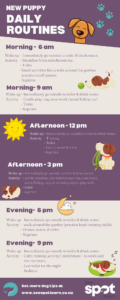New Puppy Daily Routine Guide
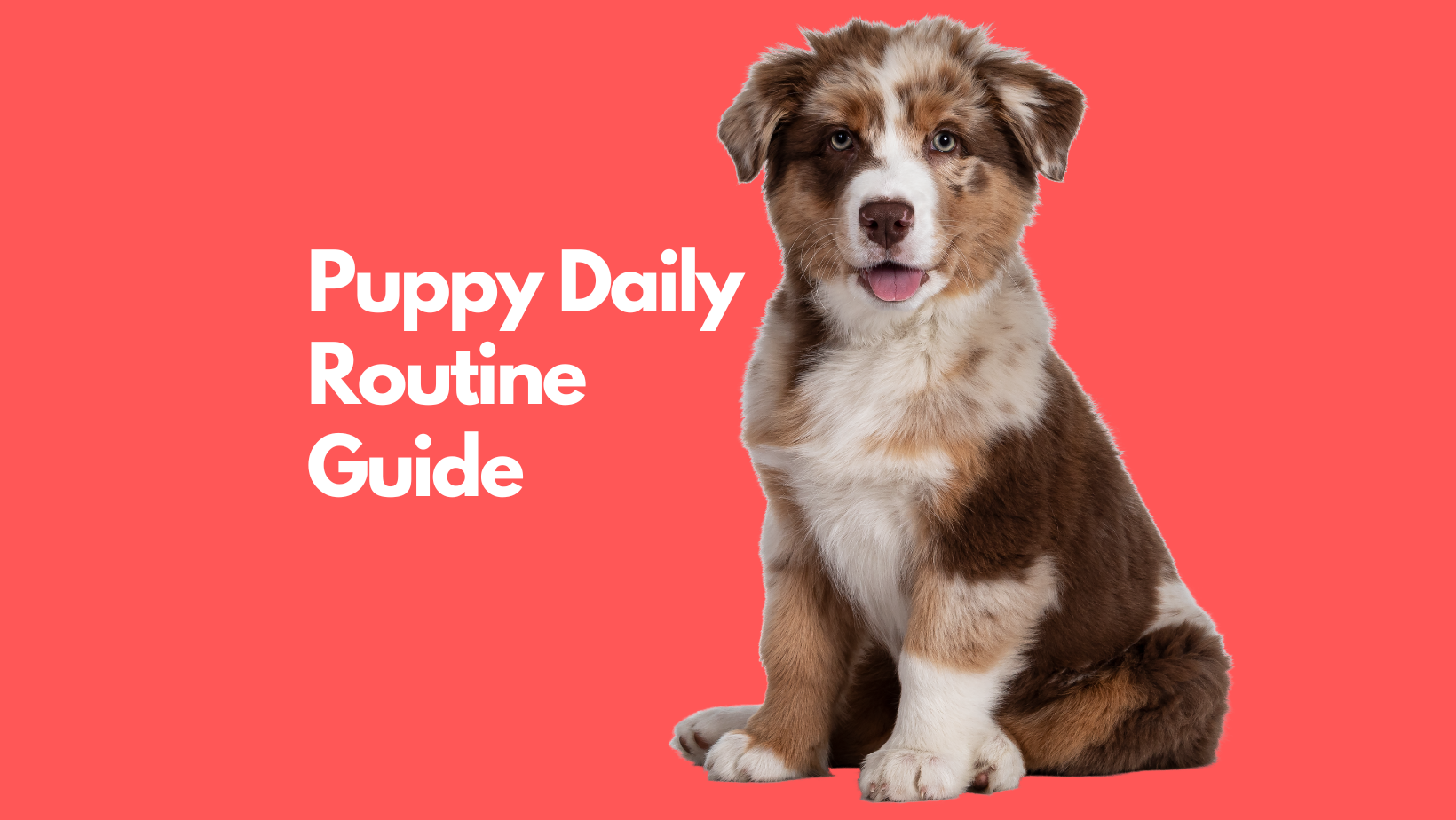
The excitement of bringing a new puppy home can be overwhelming and scary at the same time. There are so many things to think about but one of the most important things, in the beginning, is giving your new puppy time to adjust into their new home and setting up a good routine. Structure helps with predictability which helps a puppy feel safe and secure.
The first few weeks with your puppy will be an adjustment but you will succeed with a couple of tips to help you with creating a schedule. These don’t need to be followed to the letter, this is just a general guide to help you get started.
Your puppy and their feeding schedule
Your puppy will need to have multiple meals throughout the day till about 4 to 6 months of age – depending on the breed and size of your puppy. After 6 months of age, your pup can be weaned to two meals a day.
A puppy’s meal schedule should be three times a day, morning, lunch, and dinner.
Make sure that your pup’s water bowl is cleaned and changed regularly, and that they always have access to fresh water.
Toilet training
It is normal to struggle to find your pup’s toileting routine in the beginning. It is important to remember that there is only so much urine their teeny tiny bladder can hold, and the control that puppies have over their bladder varies with age.
When toilet training the pup, be calm. Never shout at them (no matter what they have done). Yelling will only frighten them and create a negative association with you. It may cause the pup to associate the behaviour of toileting in front of you is the ‘bad thing’ to do, which causes them to hide and toilet behind the couch where you can’t see them. They may not associate that you were upset with the location of toileting.
Your pup shouldn’t have free access to the entire house as that can set them up to fail. When inside with the family, the puppy’s access should be limited. They need to be kept under strict supervision so that you can learn to predict when they need to toilet. When pup is awake indoors with the family, they should be taken outside every 10 to 15 minutes in order to prevent accidents in the beginning. There is no time limit, each puppy is an individual.
The general rule is to take your puppy out to toilet immediately when they have woken from a sleep, after they have eaten or just drank water, and after any activity.
Playtime and training
To build a good relationship with your puppy they need to have time with you which involves games and fun exercise. Please be careful when it comes to physical exercise. Your pup’s growth plates don’t fully form until 18 months of age, and continuous, hard-impact exercises can damage their joints. Inappropriate overstimulating physical exercise can also lead to other behavioural problems like excessive arousal, poor impulse control, and a dog you can’t physically tire out.
Other games to avoid are rough house games where you thrust your hands in the pup’s face, or push them, as that will encourage them to bite your hands. High-speed chase games would also not be appropriate as this may cause the puppy to become over-aroused, nip, and bite your hands, arms, and legs. Games that can escalate into reactivity are not recommended especially if you have small children. These games will not be ok when your puppy is a fully grown dog.
Playing fun games that you can incorporate into training and mental stimulation is really important and very good for pups. Games are wonderful learning opportunities.
Several short sessions of fun games and exercise are more important for your growing puppy than one long session. Please see my enrichment blog for enrichment games to play https://www.seespotlearn.co.nz/post/enrich-your-dogs-life
Day naps and bedtime
Sleep is incredibly important for growing puppies and they need to have lots of rest and little naps throughout the day.
Family members (especially children) should not disturb a sleeping puppy. You may need to provide a playpen area or a crate in a quiet part of the house where your pup can’t be disturbed or distracted by the movement of your household during naptime.
Try to set a good pattern of sleep routines as it will help the puppy settle, especially at night when it’s bedtime.
The sooner you start a routine, the easier it will be for your family and puppy to adjust. Do not put pressure on yourself to follow a routine to the letter, life happens and sometimes you may not be able to and that’s ok.
The ideas below are a starting point and you may find that you will need to tailor it to suit your puppy and family.
Morning: Take your puppy out first thing in the morning so that they can relieve themselves. After your puppy has gone ‘potty’, they will be hungry so give your puppy their breakfast. I recommend leaving food down for about 15 minutes. Pick up the bowl and clean it so it’s ready for the next meal. Even though it may be convenient, I do not recommend leaving food down all the time for health and hygienic reasons. Your puppy can still benefit from treats when you are training.
After breakfast, they will need to go out to toilet again. This is great for taking advantage to help with your toilet training routine. After your puppy toilets, you can play a game or do a little bit of training. After that, your puppy will need to toilet again and then go for a nap.
Mid-morning: Your puppy should be resting through mid-morning in their crate or playpen. Even if you are home it is recommended that they still spend time there to help build independence so that they can learn to be alone when needed. The playpen will also limit your puppy’s options so that they don’t get up to ‘mischief’ when not being actively supervised.
Afternoon: Repeat the morning routine of going out after waking up to toilet and being fed. Play with your pup which can also involve mental stimulation to burn off some energy and give them something productive to do. After interacting with your pup, one more toilet break is needed before their next nap.
Mid-Afternoon: As soon as your puppy wakes from their nap take them outside to toilet. You can give them a puzzle toy for problem-solving skills to mentally tire them out, or a safe chew to nibble on to help with teething.
After an activity, game, or just hanging out with your pup, they would be ready for another toilet break and nap.
Evening: Another toilet break after their mid-afternoon nap. Channel their brain constructively by giving them their dinner in the form of a puzzle, or snuffle mat. If you’re feeding from their bowl, be sure to give them something to do after they finished their meal and are toileted.
You can also prepare their dinner and feed them while you are preparing your dinner. Pay close attention because the pup will need to be taken out to toilet once they have finished their meal.
When you sit down for your dinner you can give your puppy something yummy to chew in their crate or playpen. This will help prevent the pup from disturbing your while you eat and begging at the table.
Mid-Evening: After you have finished your dinner and the puppy has finished their chew, he or she will need a toilet break. You may find that your puppy has a lot of energy at this time of the evening and it’s normal if they do. Be ahead of the situation by initiating a calm game that works your pup’s brain. You can do some small training exercises which may help settle your pup. If you find your pup is still quite boisterous then give them something safe to chew like a deer antler, pizzle stick, goat horn, or kong stuffed with treats.
After your pup is finished and you are ready for them to go to bed take a quiet stroll in the garden. Don’t hype your puppy up with an excitable tone or games. This is a time for calm. Take this opportunity to let him toilet before going to bed for the night.
Night-time: A routine bedtime really helps the pup adjust into their new home as well as establish a good toilet training structure. Try not to use an excitable tone – be boring – you need to be calm to help the pup settle down. Make sure the room is dark and the pup isn’t exposed to loud noises and lights that could disturb their sleep.
It is ok to set an alarm if your puppy is not able to hold on the whole night. It won’t be forever. Set your alarm to wake you up just before you think your puppy will need to go toilet. When you take your pup outside for a toilet break, go straight to their toileting spot. Remember to remain calm and boring, don’t chat too much as that may excite the pup and you may struggle to get them to sleep again.
Once you are back in bed, hopefully, you get a good night’s sleep so you will be ready for the next amazing day with your beautiful puppy.
To help you along your training journey with your puppy, it’s recommended you look for a good puppy training school if you haven’t already.
Have more questions about your puppy? Reach out at spotislearning@gmail.com
HAPPY TRAINING.
Tags
What do you think?
Related Articles
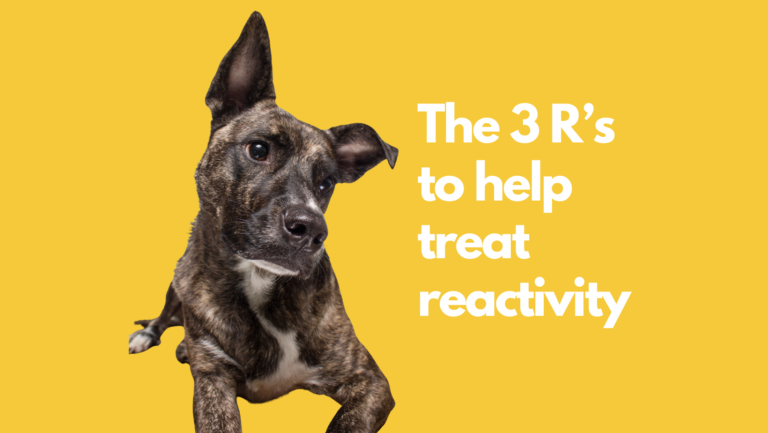
The 3 R’s to help treat reactivity
Training your dog is not just about teaching them to listen and ‘fixing’ unwanted behaviours; it’s about creating positive associations with their environment and building
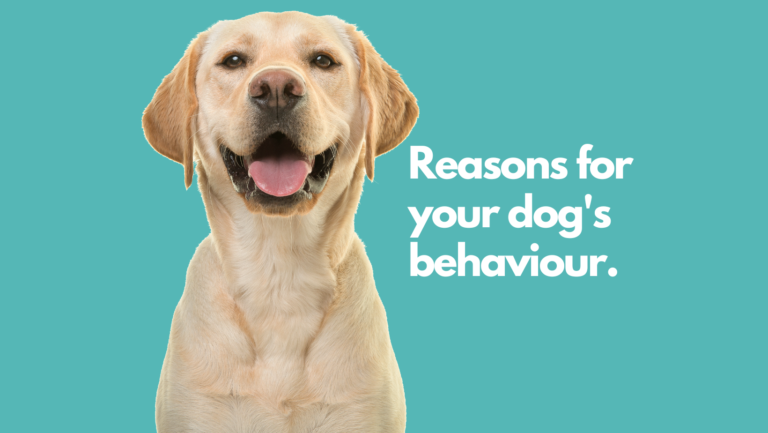
Reasons for a dogs behaviour
Dogs behave the way they do for many reasons. They do NOT do things deliberately to be stubborn or ‘naughty’, nor do they aim to
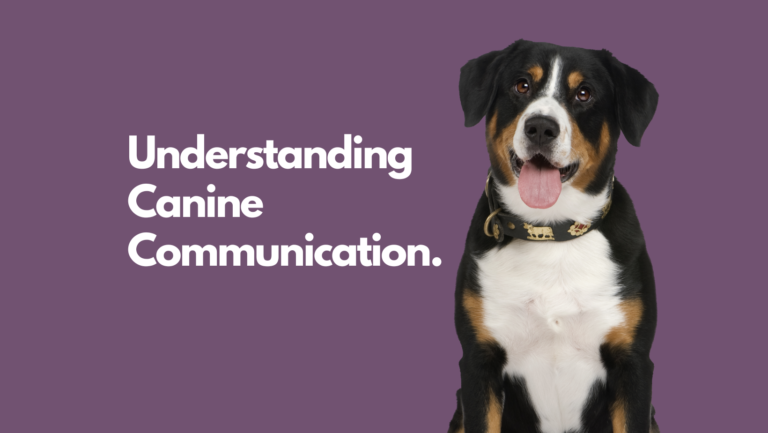
What is Dog Body Language?
Our canine friends have an intricate language of nonverbal communication known as body language. Body language is the way a dog uses his or her

